-
Date of Buddha
( V.G.Ramachandran- Ancient India, General Editor.Dr.N.Mahalingam, Published by International Society for the Investigation of Ancient Civilization, Chennai-32, Revised Edition-1998)

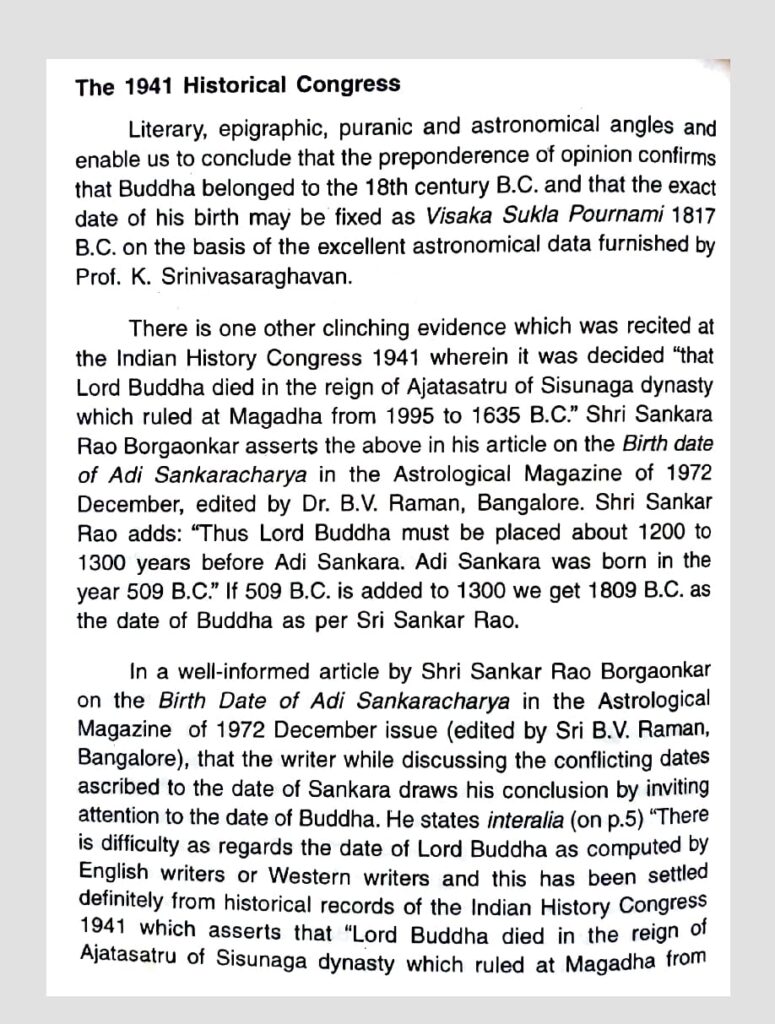
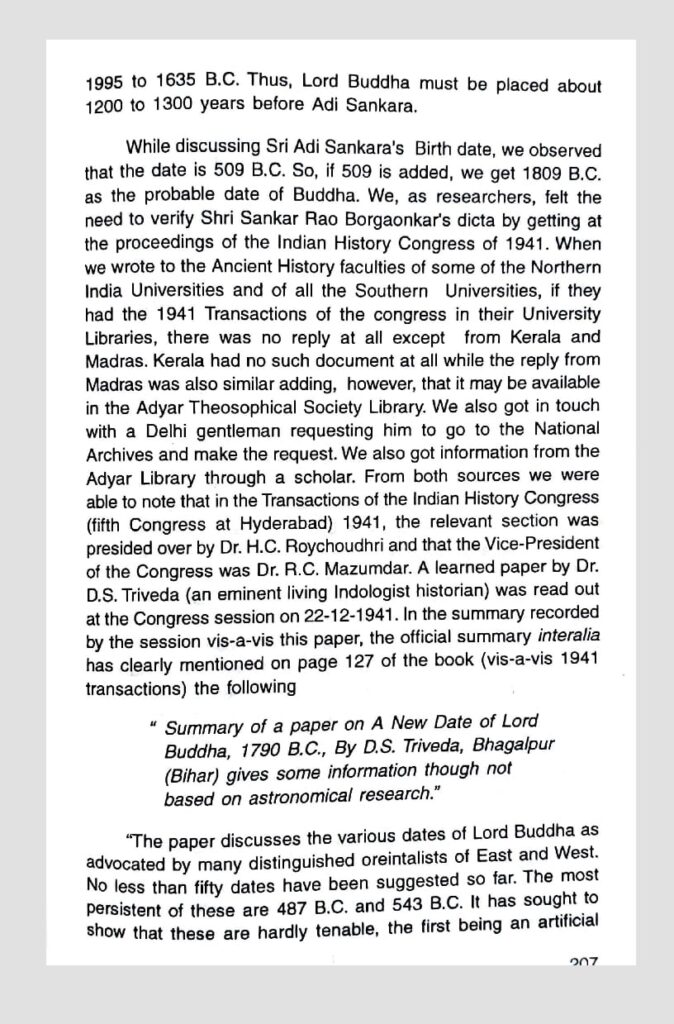
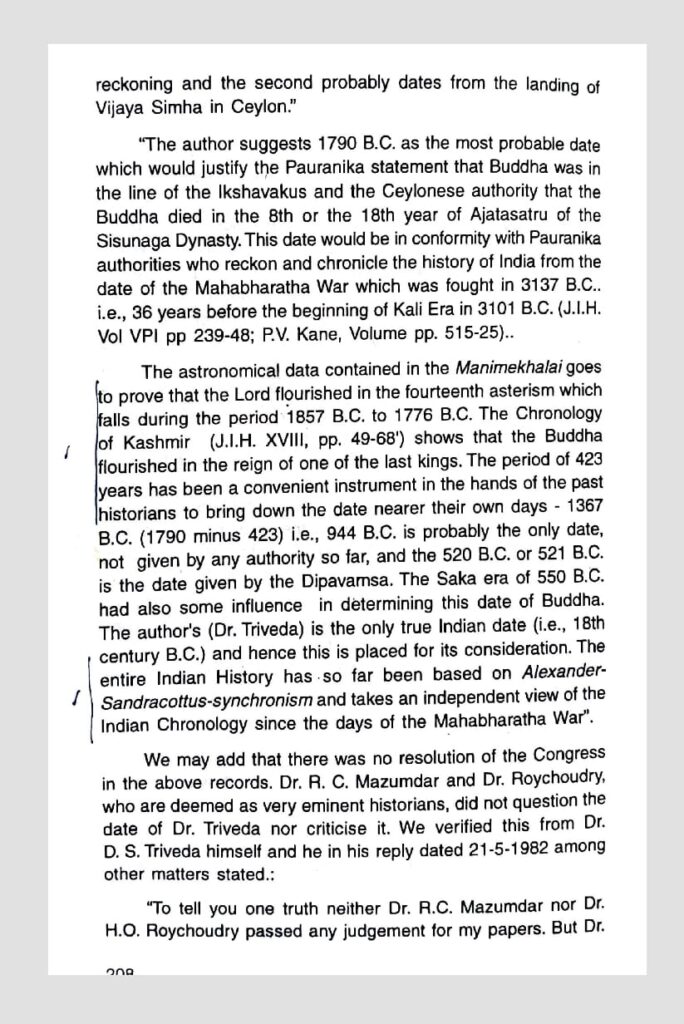
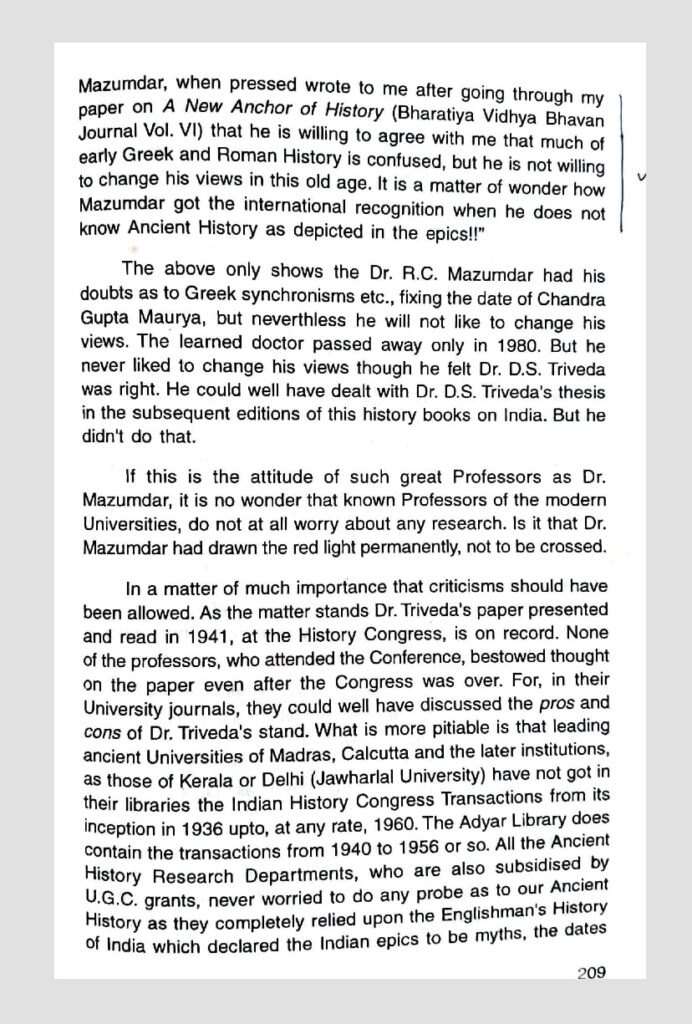
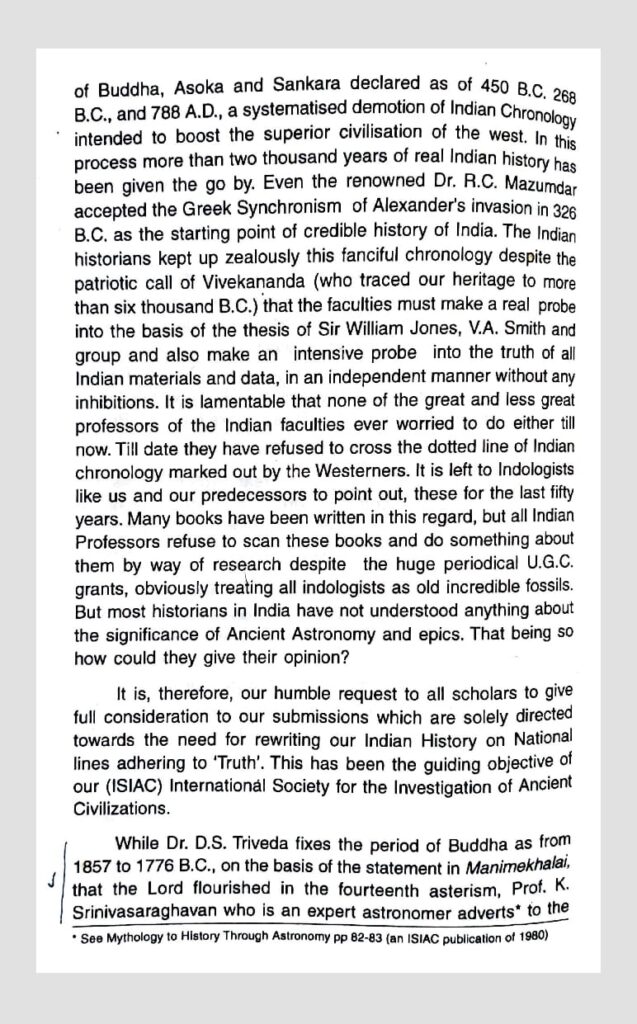
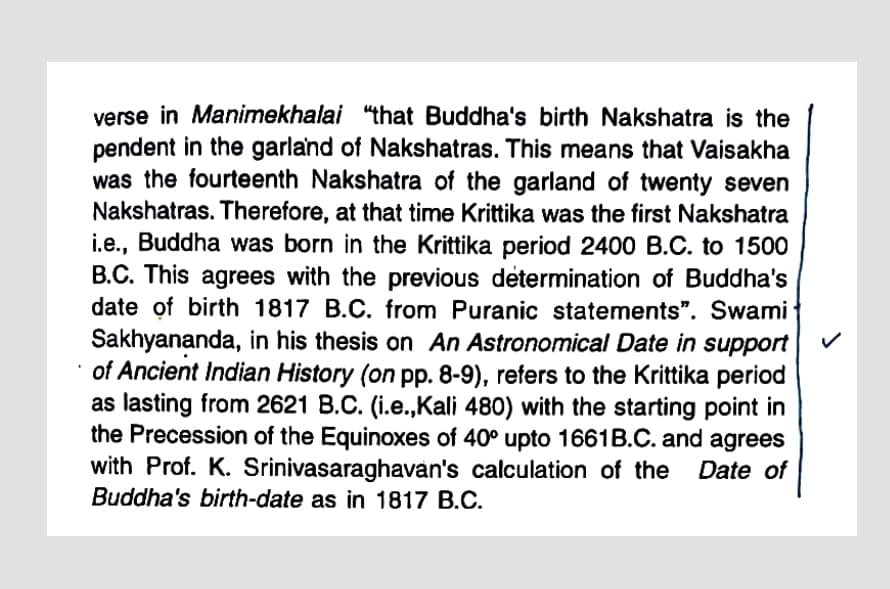
-
Sri Sankaracharya’s Disciples…1
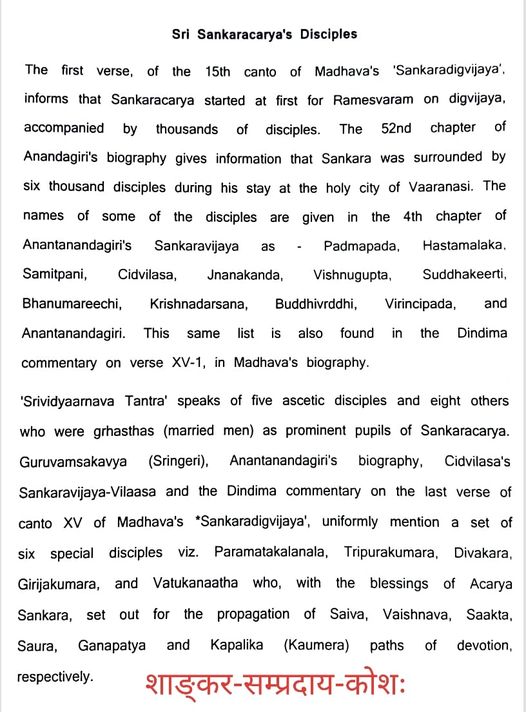
-
ShriKanchiPuram
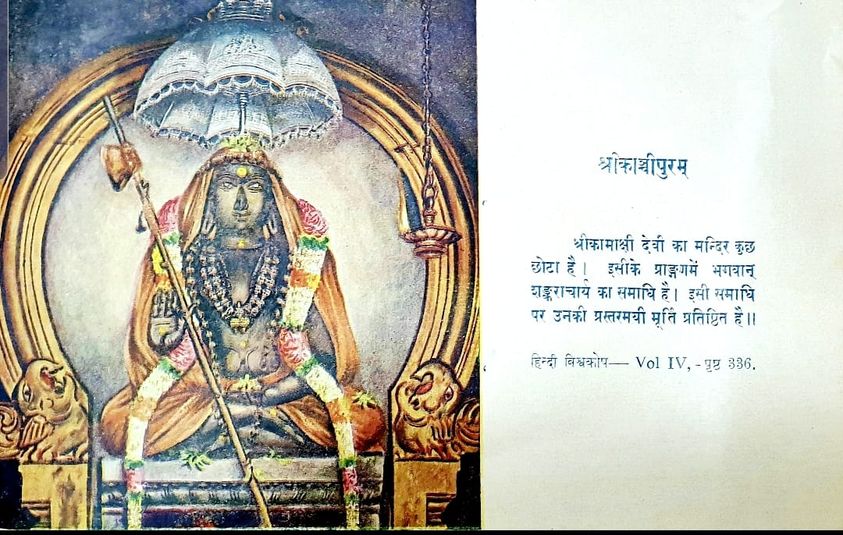
-
The Horoscope of Sankara Bhagavadpada
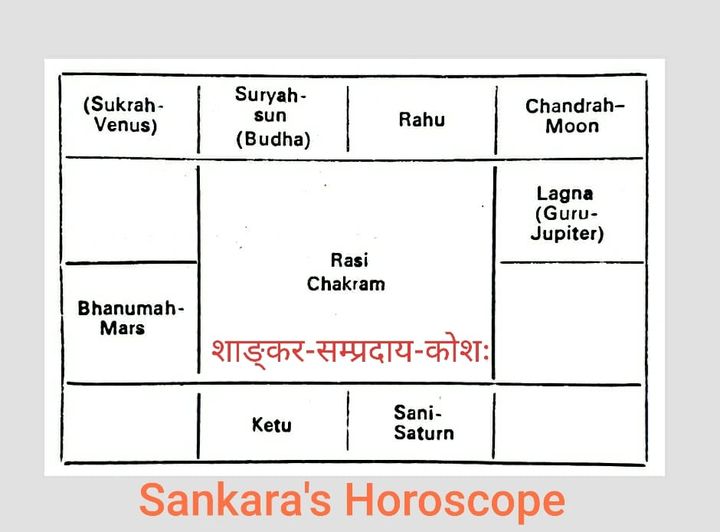
The Date of Sankara Bhagavadpada has been needlessly drawn into controversy. This is partly due to the unwholesome desire of western scholars to demote Indian Chronology so as to line it up and subordinate it to the Chronology of Greece and partly due to the confusion in the History of India written by the Western historians. Sankara’s Horoscope as given by Citsukhacharya is given below. This is in accordance with what is recorded in the 32nd prakara of his Brihat-Sankara-Vijaya.
Note :- Constellation: Punarvasu 2nd quarter Rising Sun (Lagna) Kataka (cancer)
Time: Just afternoon (Abhijit-Muhurta)
Day: Sunday
Tithi: Panchami, bright half (Suklapaksha)
Month: Visakha
Year: Nandana,
Kali 2593 (509 B.C.)
Yudhistira Saka 2631.
(Date of Sankara By V.G.Ramachandran, Published by International Society for the Investigation of Ancient Civilizations, Madras – General Editor: Dr.N.Mahalingam, 1985)
-
Pushpagiri Mathamnya Stotram
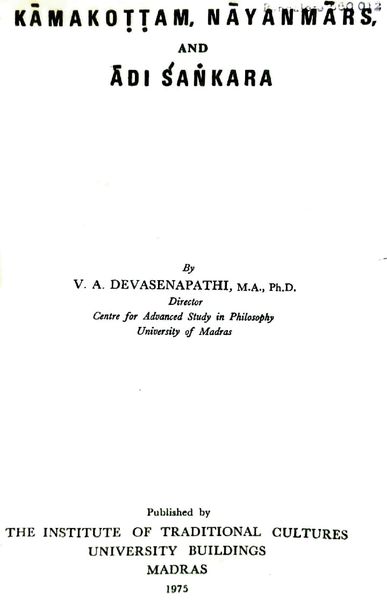
Puspagiri Mathāmnaya
” All the Sankarite Institutions in the Mysore state and Ceded Districts have the epithet “tungabhadra -tiravasi” and ” Karnataka-simhasana- pratisthapanacarya” in the preamble to epistles being issued, that is, Srimukhas.
The expression, “Karnataka-simhasana- pratisthapanacārya” refers to Vidyaranya the reputed founder of Vijayanagara Empire. In the seals of most of these institutions the name of Vidyāśankara is also embossed.
The epithets of the śrimukhams of all the institutions usually allude to the founders of the respective institutions.
And a reference to Vidyāranya stabilizing the Virūpākṣa matha and the on the banks of the river Tungabhadrā in a hymn styled Puspagiri mathāmnaya which is quoted in the Sānkaramaṭha-tattva-prakāsika – sangraha published by the great Telugu Poet, Kokundrum Venkataratnam Pantulu gāru.
He states that Vidyāraṇya came from Kañcipuram to Hampi or Virupakṣa and wrought many miracles. And after his life work in that region he returned to Kāñcipuram with great pomp and splendour. 1.
Thus Kanci has been connected with the propagation of dharma through the Sankarite Institutions in the Andhra and Karnataka regions.”
Sri Vidyanya Swami’s visit from Kanchi to Hampi Virupaksha Kshetra, establishment of Matha and His samadhi at Kanchi.
….
ततः परं गजाद्रीन्दु-रूपके शकवत्सरे ।
विद्यारण्यगुरुः काञ्ची-नगर्यां सम्बभौ महान् ।।
….
पुण्यक्षेत्रे विरुपाक्षे मठमेकं मनोहरम् ।
…..
वैशाख कृष्णपक्षस्य तृतीयायां विधोर्दिने ।
विसृज्य काञ्चीनगरं सहैश्वर्यं सवाहनम् ।।
विद्यारण्यगुरु:स्वामी कैलासालयम् आविशत् ।।
…
tataḥ param gajadrindurupake sakavatsare | vidyaranyaguruh käñcinagaryam sambabhau mahān |
….
punyakşetre virupakşe mathamekam manoharam |
…
vaisākha kṛsnapakṣasya tṛtiyāyām vidhordine visrjya kāñcinagaram sahaisvaryam savāhanam || vidyaranyaguruḥsvami kailasālayam āvisat ||
(Dr.V.A.Devasenapati, Director, Centre for Advanced Study in Philosophy, Univerity of Madras – KAMAKOTTAM, NAYANMARS AND ADI SANKARA, Published By The Institute of Traditional Cultures, University Buildings, Madras, 1975. P. 50 &51)
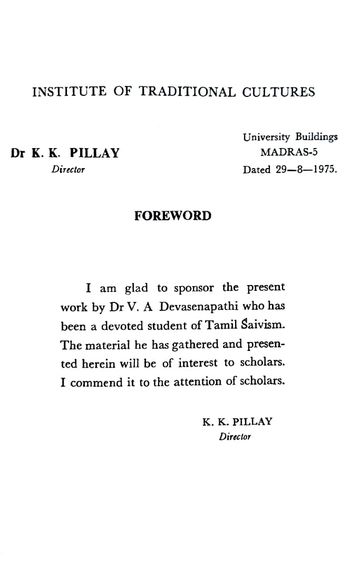
-
SIDELIGHTS ON THE DATE OF SRI SANKARA BHAGAVADPADA
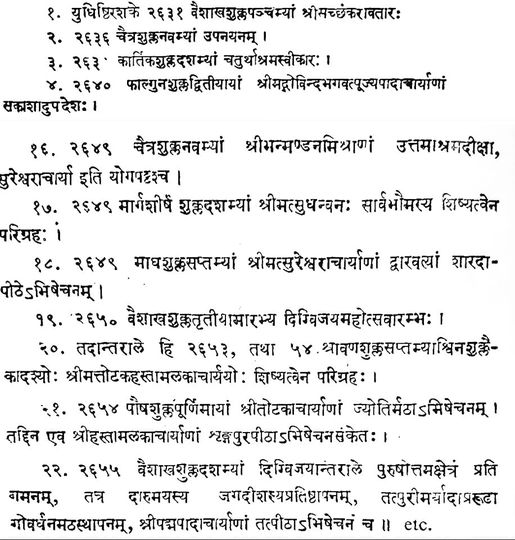
The Guruparampara of Dwaraka Matha is given in the “Vimarsa” published an Acharya of the Matha. This ancient document contains a summary of the dates of the principal events of Sri Bhagavadpada’s life. An abstract of the same is given below:
-
The Telegraph: 21.03.2003
The Telegraph: 21.03.2003
Mumbai, Jan. 20 (PTI): Putting an end to controversy, sankaracharyas across the country today unanimously accepted April 3, 509 BC as Adi Sankara’s exact date of birth.
Sankaracharyas of Kanchi Kamakoti Peetham, Dwarka Jyotirmath, Badrinath Govardhanpeeth and Puri unanimously accepted the date and said there was no need for debate on the subject.
At a seminar organised by the Ved Shastra Pandit Raksh Sabha, scholar Srikant Jichkar said the date, which was arrived at by both scientists and historians, coincides with the paramparas of the mutts across the country.
The controversy over the date that western scholars and historians in country had raised should now come to an end, he said.
Kanchi sankaracharya Jayendra Saraswathi said according to Indian philosophy, “we have to regard tradition, and since no political party or government in the country has understood the importance of Indian tradition, it is the duty of spiritual leaders to come together to establish this date as the beginning of determining and asserting many more truths of Bharat, now India”.
The seers urged the government to organise Adi Sankara’s birth centenary celebrations at his birthplace, Kaladi in Kerala, in 2010.
https://www.telegraphindia.com/india/adi-sankara-birthdate-row-ends/cid/965788
-
GURUPARAMPARA STOTRAM
संस्थाप्य स्वमठं कृत्वा तुङ्गभद्रा नदीतटे ।
तत्र स्थित्वा द्वादशाब्दं यतिं पृथ्वीधराभिधम् !
विद्यापीठाधिकं कृत्वा भारती संज्ञया गुरुः ।
आगच्छत्स्वेच्छया काञ्चीं पर्यटन् पृथिवीतले ॥
तत्र संस्थाप्य कामाक्षीं जगाम परमं पदम् ।
विश्वरूपयतिं स्थाप्य स्वाश्रमस्य प्रचारणे ॥
स्वयं काञ्चीमगात्तूर्णं श्रीपृथ्वीधरभारती ।
तद्वृत्तान्तं समाकर्ण्य तपसस्सिद्धये तदा ॥
” Having established his own matham there at the banks of Tungabhadra, the Acharya anointed Sri. Prithvidhara, as the head of that monastery, the center for learning and gave Bharatii as his dīksha name.
Later he moved to Kanchipuram on his own will by visiting various kshetras enroute. He established Kamakhi there and attained moksha.
Meanwhile Prithvidhara, after hearing the news of Acharya leaving this world, anointed Viswarūpa as his successor to carry out the activities enshrined in the directives of his Guru, visited kanchi himself very quickly.”
[Manuscript No. 2146 (i) – Jambunatha Bhat Landage Collection – The List of Pontifical Preceptors of the Bharati Ascetic order of the Tungabhadra region forming part of the Reports on Sanskrit Manuscripts in South India, Volume III. (1905). [Vide Madras Govt. Oriental Mss. Library, VI-B, Nos. 18-20.] Published by Dr. E. Hultzsch. (a German scholar) ]
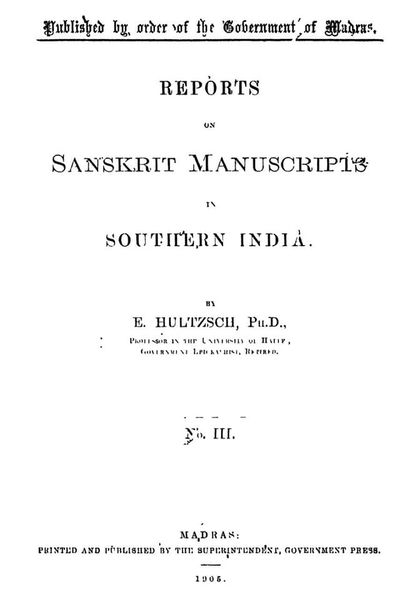
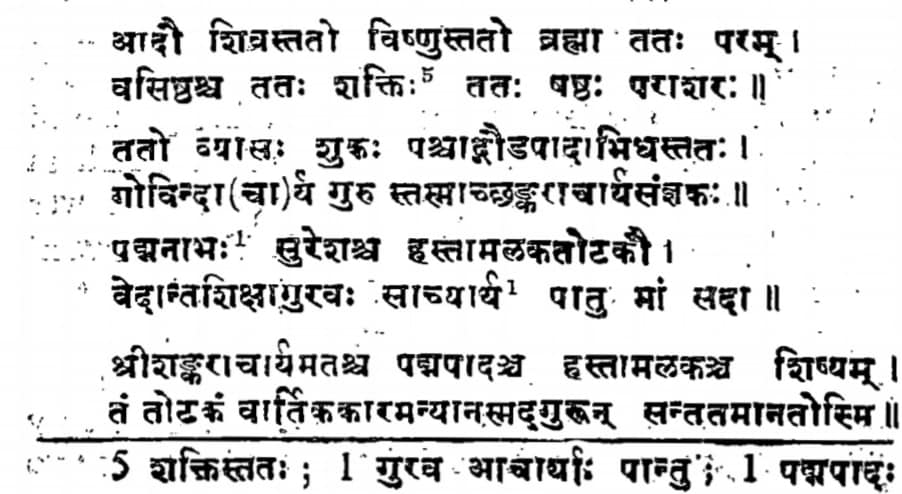
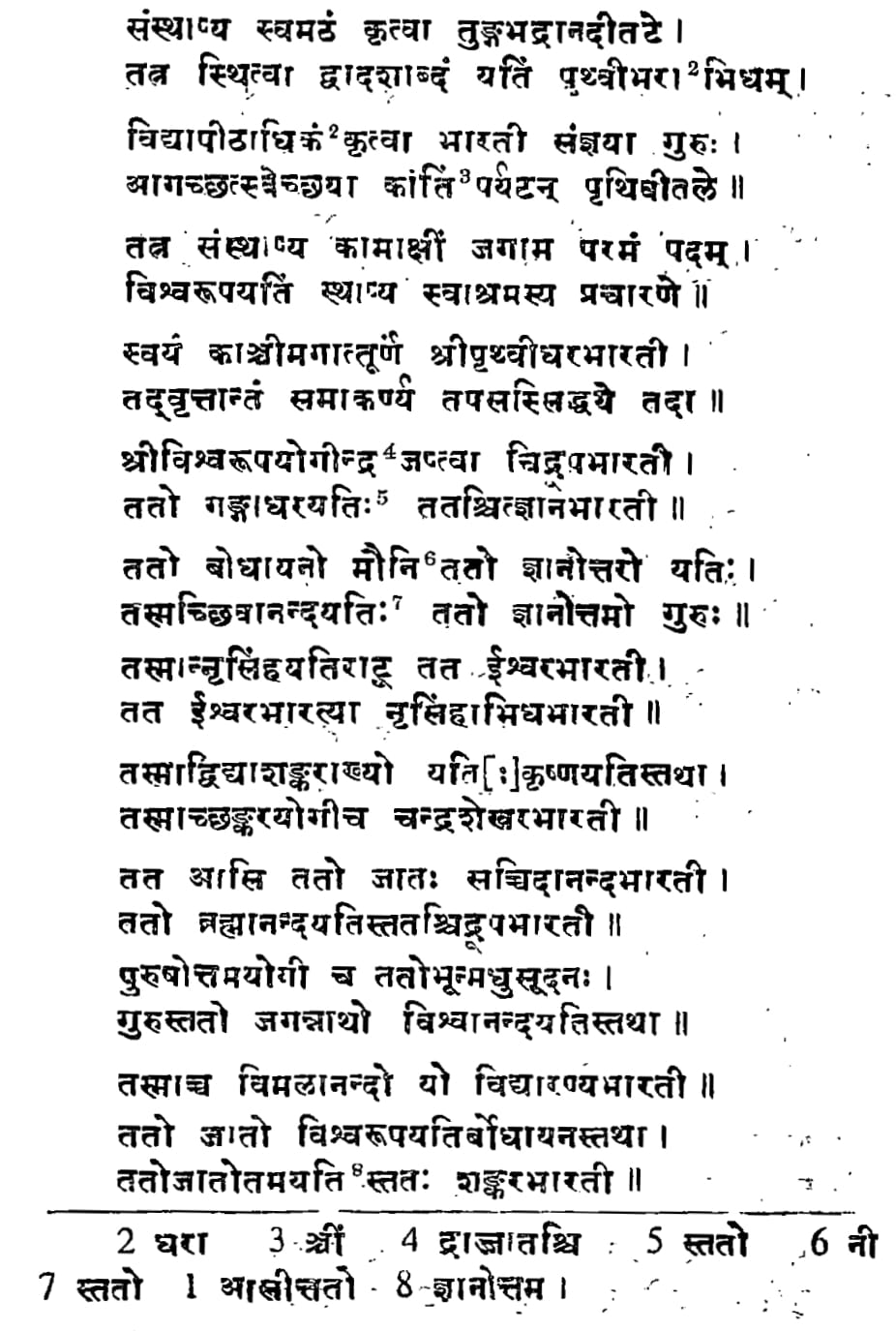
-
Sri Govardhanamatha Jagadguru Parampara Namamala
Sri Govardhanamatha Jagadguru Parampara Namamala
(SRI SAMKARACHARYA – K.G.Natesa Sastri, B.A., M.A.R.S.)
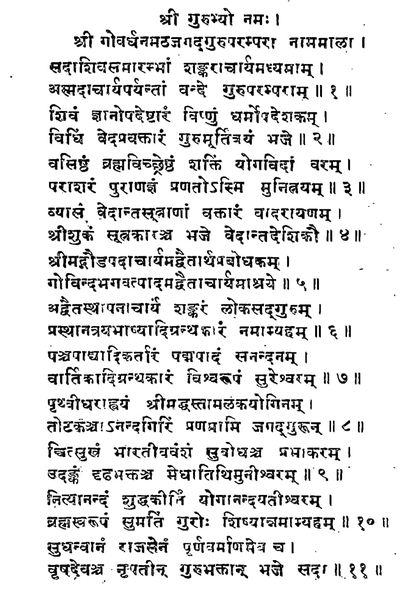
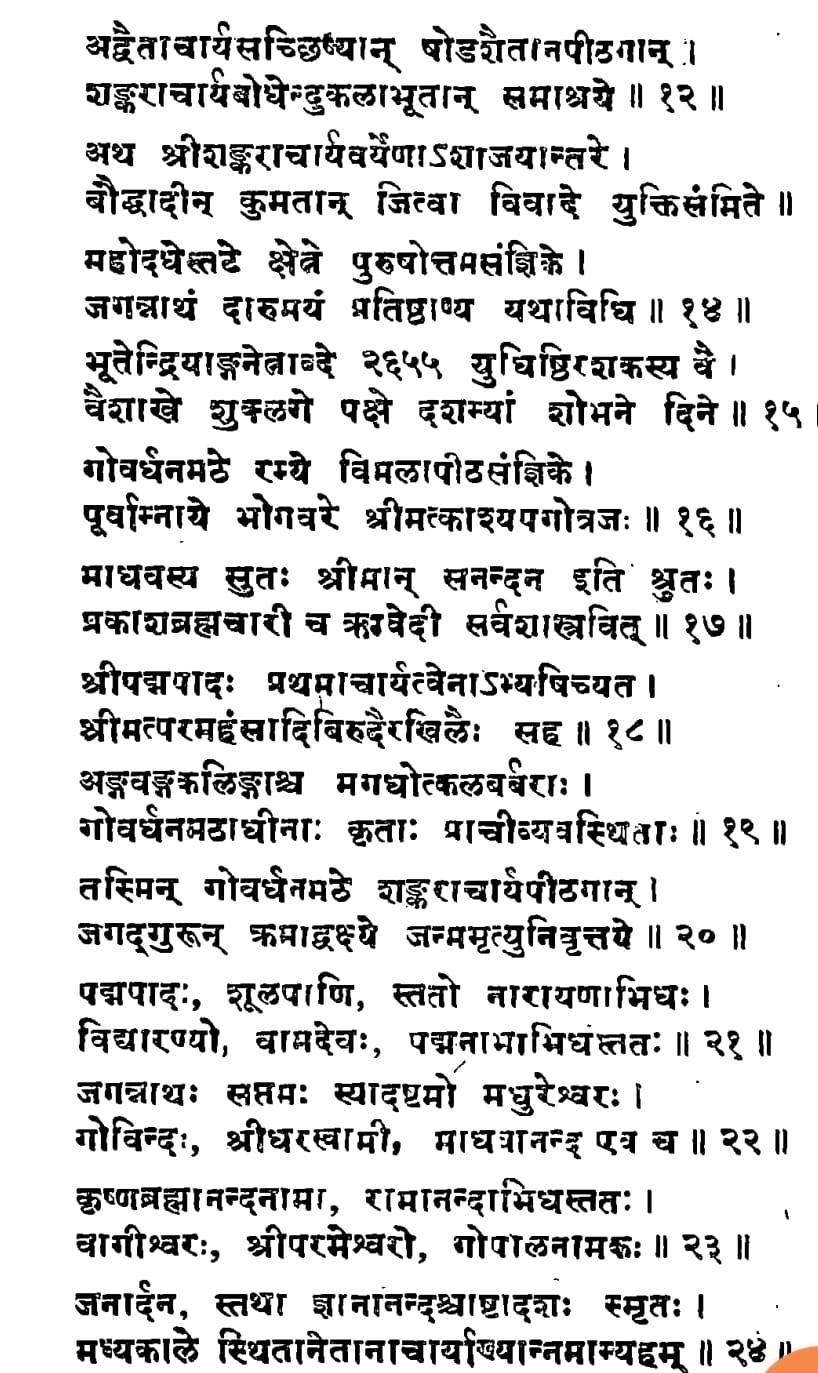
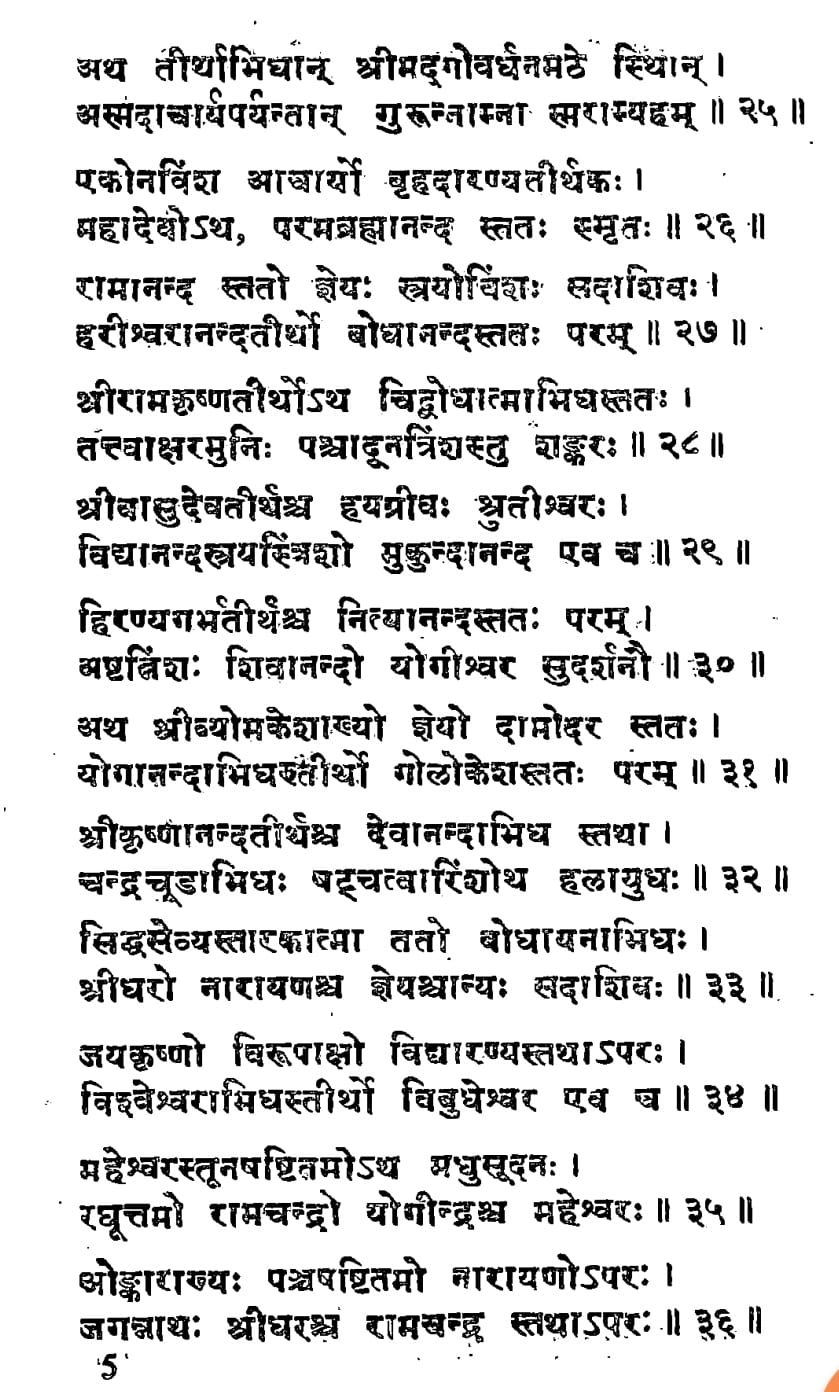

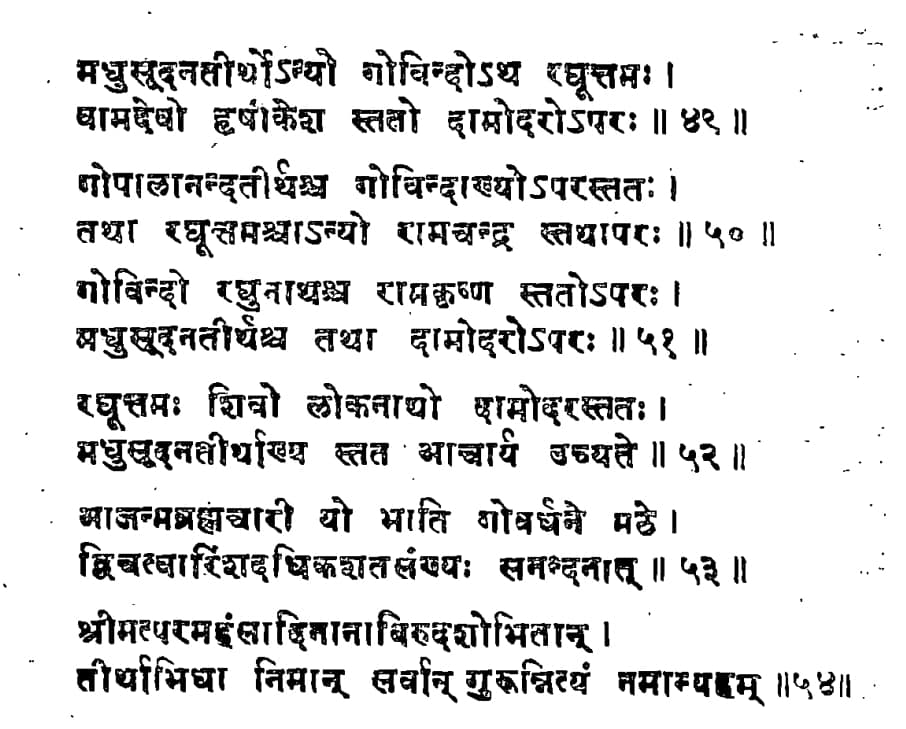
-
SRI KANCHI KAMAKOTI SANKARACHARYA MATH

Shri.N.Krishnaswami Reddi,
Former Justice, Madras High Court
Sri Sankara Bhagavatpadacharya stands unique among the great philosophers and spiritual revivalists of the world. He has shone as a great preceptor, as a conspicuous writer, as a commendable commentator, as a versatile poet and as a dis cerning dialectician. The fact that many a leading philosopher and scholar who thrived during Sankara’s own life-time and during the long centuries thereafter, have produced further commentaries on his inimitable gloss on Vyasa’s Brahmasutras, stands testimony to Sankara’s lucid exposition of terse metaphysics.
Sankara’s name and fame have left an everlasting impression in the minds of the vast majority of Indi ans. A significant number of erudite foreign scholars and thinkers have paid culo gistic tributes to Sankaracarya. For the devout Hindu, Sri Sankara is a Super-human luminary, verily an incarnation of the Divine.
All biographies of the Acharya are uniform in stating that, even when a boy, he was a prodigious intellectual. Becoming an ascetic at the age of eight, having under gone the formalities of the ascetic order under Sri Govinda Bhagavatpada, Sankara is said to have completed the production of the famous commentaries on the Brahmasutras, on the Bhagavat Gita, the principal Upanishads etc., during his stay at Varanasi, according to the directions of his preceptor, by his sixteenth year.
By continued, long and wide travel, on foot, almost through every nook and corner of Bharat, by his disso lution of non-Vedic heretic sects by disputation, by the propagation of the Advaita dis cipliine and by his stabilising the six-fold devotional path (Saiva, Vaishanava, Sakta, Ganapatya, Saura and Kaumara) on the Vedic base, Sankara has been a great na tional integrator.
It is a pity that information regarding the various important sacred places, vis ited by Sankara during his long and extensive tours, as recorded in the many biographies, is not uniform But the Great Acarya’s visits to Prayag, Varanasi, Badrinath (the Northern dham), Rameswaram (the Southern cardinal corner) and to Kanchi, the Southern Mokshapuri, are pointed out in all biographies, though differing in order, context and timing.
In some of these accounts, a chapter or two or even more are devoted to de scribe Sankara’s arrival at Kanchi and his performances there. Some biographies give short accounts about some specific event that has happened during his stay in the sacred city. A significant number of works in Sanskrit or in other languages, bio graphical or otherwise, point to Kanchi, the Southern Mokshapuri, as the last resort of Adi Sankaracharya.
From authentic literary sources ancient or modern-, from information gained from epigraphical and archaeological sources, and according to long-standing tradition, Sankaracharya has established monastic institutions (maths) at many important and sacred places visited by him, during the course of his extensive travels through the length and breadth of the country. Among such institutions the Sankaracarya Math, established by Sankara at Kanchi and presided over by the Acharya himself, is a pre mier one. Scholarly and austere ascetic pontiffs have adorned the Kanchi Math.
The copper-plate grants and stone inscriptions pertaining to the Kanchi Kamakoti Sankaracarya Matha were published during 1909 and 1987 .
A perusal of the text and abstract of the contents of three of the seven copper epigraphs of the Mutt (Nos. 1, 6 and 7) would make it evident that the personal name of the donce Svami is not indicated in each case. Only “Sankararya Guru” of the “Matha at Kanci” is found in copper-plate No.1. In the 6th, neither the personal name of the donor nor of the donee can be traced.
Epigraphists, after a thorough examination, have, however, been able to fix the donor as Tana Shah, the last Sultan of the Qutub Shahi dynasty of Rulers of Golconda. This epigraph (in the nature of an order), speaks of an annual contribution in cash out of the revenue of a village in the Chengleput District (Tamil Nadu), for the “Maintenance of lamps and offering of oblations to God Chandramauleesvara worshipped by Paramahamsa Parivrajakacarya Sri Sankaracharya Swami, in the Sarada Matha, in the divine city of Kanchi”.
The last in the series of copper-plate inscriptions is dated in 1710 A.D. It records the grant of tax free lands in eight villages in the Tiruchirapalli district (Tamil Nadu) for purposes of worship, feeding of brahmins etc., in the Matha at “Gajaranyakshetra” (Tiruvanaikoil near Tirchirapalli), by a Nayak ruler of Madurai.
The Matha at Gajaranyakshetra is a branch Math of the Sankaracharya Math at Kanchi. In this epigraph the donec Swami is indicated as “Kancipurasthita Srimacchankara Bhagavatpadacarya Swami” and as “Lokaguru Swami Sri Sankaracarya”.
Moreover, this epigraph points to the fact that the branch Math at Tiruvanaikoil has been owned by the Acharyas of the Kanchi Matha from “ancient times”.
The absence of the mention of the personal names of the pontiffs of the Kanci Sankaracarya Matha, of the times, in the three grants, mentioned above, serves to clearly indicate the wide popularity and pre-eminence of the Kanchi Sankara Matha, in the entire southern part of the country.
The six stone inscriptions pertaining to the Sankaracharya Matha of Kanchi, ranging in time from the early part of the 16th century (A.D.), till the seventh decade of the last century. These stone epigraphs are much informative.
I feel extremely happy in having done a humble bit of service by writing an introduction to the volume of inscriptions relating to Sri Sankara Bhagavatpadacharya’s ancient Matha in the sacred city of Kanchi.
